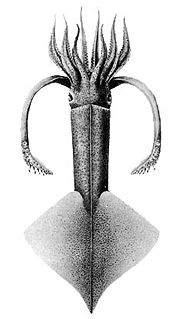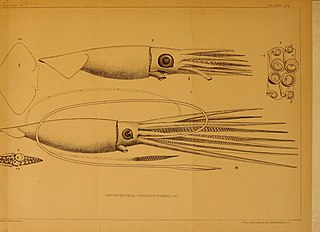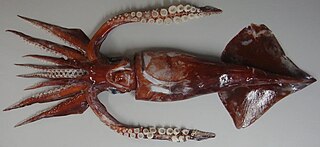
The Mastigoteuthidae, also known as whip-lash squid, are a family of small deep-sea squid. Approximately 20 known species in six genera are represented, with members found in both the mesopelagic and bathypelagic zone of most oceans. Originally described by Verill in 1881, it was later lowered by Chun (1920) to a subfamily (Mastigoteuthinae) of the Chiroteuthidae. However, Roper et al. (1969) raised it back to the family level, and this has not been changed since. The taxonomy of this family is extremely unstable, and there have been at times one genus, two genera and four subgenera(Salcedo-Vargas & Okutani, 1994), two genera and several 'groups', five genera and one species with an uncertain placement, or six genera.

The hooked squid, family Onychoteuthidae, currently comprise about 20–25 species, in six or seven genera. They range in mature mantle length from 7 cm to a suggested length of 2 m for the largest member, Onykia robusta. The family is characterised by the presence of hooks only on the tentacular clubs, a simple, straight, funnel–mantle locking apparatus, and a 'step' inside the jaw angle of the lower beak. With the exception of the Arctic Ocean, the family is found worldwide.

Onykia ingens, the greater hooked squid, is a species of squid in the family Onychoteuthidae. It occurs worldwide in subantarctic oceans.

Onykia robusta, also known as the robust clubhook squid and often cited by the older name Moroteuthis robusta, is a species of squid in the family Onychoteuthidae. Reaching a mantle length of 2 m (6.6 ft), it is the largest member of its family and one of the largest of all cephalopods. The tentacular clubs are slender, containing 15–18 club hooks. Arms of the species contain 50–60 suckers, and grow to 90–100% of the mantle length. It is found primarily in the boreal to Temperate Northern Pacific.

Onychoteuthis banksii, the common clubhook squid, is a species of squid in the family Onychoteuthidae. It is the type species of the genus Onychoteuthis. This species was thought to have a worldwide distribution but with the revision of the genus Onychoteuthis in 2010, it is now accepted that Onychoteuthis banksii is restricted to the central and northern Atlantic and the Gulf of Mexico while a recently described species, Onychoteuthis horstkottei, is found in the Pacific Ocean. The type locality is the Gulf of Guinea.
Magnoteuthis is a genus of whip-lash squid containing at least three species. Some teuthologists consider Idioteuthis or Mastigoteuthis synonymous with this taxon, but it is genetically and morphologically distinct.
Moroteuthopsis(previously Kondakovia) is a genus of squid in the family Onychoteuthidae. The type species is Moroteuthopsis longimana.

Asperoteuthis is a genus of chiroteuthid squid comprising four species:

Magnoteuthis microlucens is a species of squid; the most common species of Mastigoteuthis around the main Hawaiian Islands.

Onychoteuthis is a genus of squid in the family Onychoteuthidae. The type species is Onychoteuthis bergii. While the genus is found worldwide in tropical and subtropical oceans, they can also occur in the North Pacific Ocean. There were previously considered to be four species in the genus but there are now considered to be roughly 10. These squid are frequently observed in the surface waters at night and they are often caught using dipnet at nightlight stations. The young squid are usually the only specimens captured using standard midwater trawls, the older squid are apparently able to avoid the trawls. They can, however be collected from the air as individuals are able to leap high out of the water, sometimes even landing on the deck of a ship.

Onychoteuthis borealijaponica, the boreal clubhook squid, is a species of squid in the family Onychoteuthidae. It is the largest member of the genus Onychoteuthis, reaching a mantle length of 30 cm in males and 37 cm in females. Maturity is reached at 250 mm for males, and 300–350 mm in females. There are 24–27 hooks on each club, which is more than any other species in the genus Onychoteuthis. It is a pelagic species native to the North Pacific, although it migrates into Subarctic waters during the summer from its more southerly winter spawning grounds.
Onychoteuthis meridiopacifica is a species of squid in the family Onychoteuthidae. Males become mature at 40 mm, and the species is believed to reach a maximum mantle length of 90 mm, the smallest species in the genus Onychoteuthis. The tentacular club reaches a length of 20-25% of the mantle length, and contains 16-19 club hooks. Arms reach 27-44% of the mantle length, and each contain 50-60 suckers. 8-12 nuchal folds are present on each side of the head. Its short, broad fins and the possession of a small number marginal suckers on the tentacular clubs of adults are distinguishing characteristics of this species. It is found off eastern Australia and probably extends into seas off Indonesia as well as east to Tonga and Vanuatu.
Notonykia africanae is a species of squid in the family Onychoteuthidae. It is the type species of the genus Notonykia. While the mature size of the species is unknown, it is known to reach a mantle length of at least 180 mm. Tentacles reach approximately 70% of the mantle length, and contain 14-20 club hooks. Arms are known to reach 27-45% and 33-55% of the mantle length; each containing 50-60 suckers. The species is located in southern waters off Australia, Tasmania, New Zealand and South Africa.
Notonykia is a genus of squid in the family Onychoteuthidae. The type species is Notonykia africanae.
Walvisteuthis virilis is a species of squid from the family Onychoteuthidae, it is the type species of the genus Walvisteuthis. It may be synonymous with Walvisteuthis rancureli. The type specimen was collected a mature male with a mantle length of 71 mm collected near the Walvis Ridge in the eastern South Atlantic Ocean at a depth of 1000m. A second specimen was subsequently collected on the other side of the South Atlantic, also a mature male with a total length of 71mm.

Uroteuthis is a genus of 14 species of common inshore squids of the Indo-West Pacific and is further subdivided into 3 subgenera. The members of the genus Uroteuthis are the only squids of the family Loliginidae that possess photophores and all species in the genus have a pair of photophore organs on the ventral surface of their ink sac either side of their intestine.
Richard E. Young is a teuthologist. He is an Emeritus Professor of Oceanography at the University of Hawaii's School of Ocean and Earth Science and Technology.
Nototeuthis is a monotypic genus of squid, in the family Neoteuthidae. The only species in this genus is Nototeuthis dimegacotyle . This species is characterised by short tentacular clubs, less than 40% of the length of the mantle, and relatively long fins, which are approximately 60% of the mantle length. The tentacle clubs have two greatly enlarged suckers on distal portion of the manus, which distinguish N. dimegacotyle from other members of the Neoteuthidae. Few specimens of this species are currently known. Specimens have been collected from the south eastern Pacific Ocean, off Chile, between the Southern Subtropical and the Antarctic Polar frontal zones. This species is mesopelagic to bathypelagic and can be found from near the surface to a depth of ~500m.

Sthenoteuthis is a genus of small squids, with two species, part of the subfamily Ommastrephinae within the family Ommastrephidae, the "flying squids". They are the dominant species of flying squid in the world's tropical and subtropical seas and they are commonly seen at the ocean's surface during the night. Their size ranges from mantle lengths of 100 mm to 600 mm.

Todarodes is a genus of flying squid from the subfamily Todarodinae, of which it is the type genus. The genus contains five species which are partially allopatric but between them their distributions encompass most of the world's oceans and seas. These squid have a funnel groove with foveola, a hectocotylised fourth arm and tentacular stalks which lack free trabeculae.












